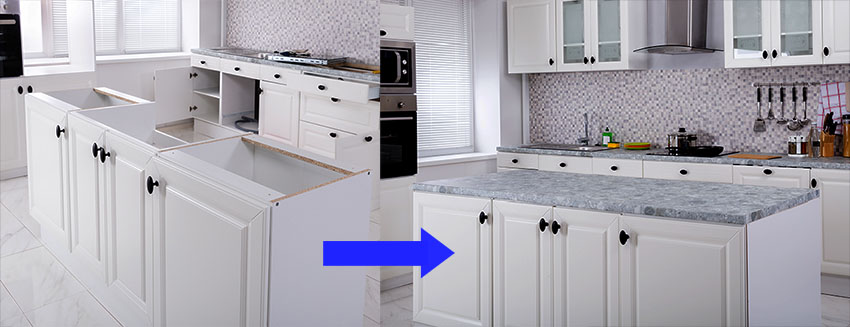If you're looking to change up the layout of your kitchen or simply want to give it a fresh look, moving your kitchen sink over can make a big impact. It may seem like a daunting task, but with the right tools and knowledge, it can be a relatively simple project. In this guide, we'll walk you through the step-by-step process of moving your kitchen sink over. First and foremost, it's important to plan out your new sink location. Consider the layout of your kitchen and where the new sink will best fit in. Keep in mind the plumbing and electrical connections as well. Once you have a plan in place, here are the steps to moving your kitchen sink over: Step 1: Prepare the new sink location by measuring and cutting out the area for the sink. Make sure to leave enough room for the sink and any additional fixtures, such as a garbage disposal. Step 2: Shut off the water supply to your sink and disconnect any plumbing connections, including the faucet and drain. Step 3: Remove the old sink from its current location. This may involve cutting through any caulk or adhesive holding it in place. Step 4: Install a new drain and faucet in the new sink location. You may need to make adjustments to the plumbing to fit the new location. Step 5: Place the new sink in its new location and secure it in place with caulk or adhesive. Step 6: Reconnect the plumbing and water supply. Make sure all connections are secure and there are no leaks. Step 7: Test the sink by running water and checking for any leaks. Make any necessary adjustments. Step 8: Finish off the sink installation by caulking around the edges and sealing any gaps.1. Moving a Kitchen Sink Over: A Step-by-Step Guide
Moving a kitchen sink can be a tricky task, but with these tips and tricks, you can make it a smoother process: Tip 1: Before starting the project, make sure you have all the necessary tools and materials ready. This includes a new sink, plumbing supplies, and caulk or adhesive. Tip 2: Consider hiring a professional if you are not confident in your DIY skills. A professional can ensure the job is done correctly and efficiently. Tip 3: Take into account the existing plumbing and electrical connections. Moving the sink may require additional adjustments to these connections. Tip 4: Plan out the new sink location carefully. Consider the flow of the kitchen and make sure the new location is functional. Tip 5: Consider upgrading your sink while you're at it. This may be a good opportunity to invest in a new, more efficient sink with added features.2. How to Relocate a Kitchen Sink: Tips and Tricks
Moving a kitchen sink over is not just about the physical task of relocating the sink. There are a few important things you need to know before starting the project: 1. Cost: The cost of moving a kitchen sink can vary depending on the complexity of the project and whether you hire a professional or do it yourself. On average, it can cost anywhere from $300 to $800. 2. Time: Depending on your DIY skills, moving a kitchen sink can take anywhere from a few hours to a full day. It's important to plan accordingly and allow for extra time in case any unexpected issues arise. 3. Plumbing and Electrical: As mentioned before, moving the sink may require adjustments to the plumbing and electrical connections. It's important to have a basic understanding of these systems or hire a professional to ensure everything is done correctly.3. Moving a Kitchen Sink Over: What You Need to Know
When it comes to moving a kitchen sink over, there are some common mistakes that can easily be avoided: 1. Not planning the new location carefully: As mentioned before, it's important to carefully plan out the new sink location to ensure it is functional and fits in with the overall layout of your kitchen. 2. Rushing the project: Moving a kitchen sink may seem like a simple task, but it's important to take your time and do it properly. Rushing through the project can lead to mistakes and potential issues down the line. 3. Not turning off the water supply: It's crucial to shut off the water supply before disconnecting any plumbing connections. Forgetting this step can result in a messy and potentially damaging situation. 4. Not testing for leaks: After reconnecting the plumbing and water supply, it's important to thoroughly test for leaks. This can save you from dealing with a major issue later on.4. Relocating a Kitchen Sink: Common Mistakes to Avoid
Before deciding to move your kitchen sink over, it's important to consider the pros and cons: Pros: - Can give your kitchen a fresh look - Can improve the functionality of your kitchen - Can allow for more counter space Cons: - Can be a time-consuming project - May require adjustments to plumbing and electrical connections - Can be costly if hiring a professional5. Moving a Kitchen Sink Over: Pros and Cons
One of the main concerns when moving a kitchen sink is potentially damaging the countertop. Here are some tips to prevent this from happening: 1. Use a heat gun: If your sink is caulked or adhered to the countertop, use a heat gun to soften the adhesive and make it easier to remove the sink without damaging the countertop. 2. Be gentle: When removing the sink, try to be as gentle as possible and avoid using excessive force. This can help prevent any damage to the countertop. 3. Use a putty knife: A putty knife can be a useful tool for prying the sink away from the countertop without causing damage.6. How to Move a Kitchen Sink Without Damaging Your Countertop
While DIY projects can be fulfilling, it's important to consider whether moving a kitchen sink over is worth the time and effort. Here are some factors to consider: 1. Your DIY skills: If you have experience with plumbing and basic home renovations, you may feel confident in tackling this project. However, if you have little to no experience, it may be wise to hire a professional. 2. The complexity of the project: Depending on the layout of your kitchen and the current plumbing and electrical connections, moving a kitchen sink over can be a complex project. Be realistic about your abilities and the potential challenges you may face. 3. The potential cost of mistakes: If you make a mistake during the project, it can end up costing you more in the long run to fix it. Consider whether it would be more cost-effective to hire a professional from the beginning.7. DIY Kitchen Sink Relocation: Is It Worth It?
As mentioned before, the cost of moving a kitchen sink can vary depending on the complexity of the project and whether you hire a professional or do it yourself. Here are some cost and time considerations to keep in mind: Cost considerations: - Cost of materials (sink, plumbing supplies, caulk/adhesive) - Cost of hiring a professional (if applicable) - Cost of potential mistakes and repairs Time considerations: - Time to plan and prepare for the project - Time to complete the project - Time for any potential setbacks or mistakes8. Moving a Kitchen Sink Over: Cost and Time Considerations
When it comes to moving a kitchen sink over, the decision to hire a professional or do it yourself ultimately depends on your skills and resources. Here are some factors to consider: 1. Your DIY skills: If you have experience with plumbing and home renovations, you may feel confident in tackling this project. However, if you have little to no experience, it may be wise to hire a professional. 2. Time and effort: Moving a kitchen sink over can be a time-consuming and physically demanding project. If you have a busy schedule or limited physical abilities, it may be worth it to hire a professional to save yourself the time and effort. 3. Cost: While hiring a professional may be more expensive upfront, it can end up saving you money in the long run if you make a costly mistake during the project.9. Hiring a Professional vs. DIY: Moving a Kitchen Sink Over
If a full renovation is not in the budget, there are some creative ways to move a kitchen sink over without renovating the entire kitchen: 1. Opt for a portable sink: Portable sinks can be a temporary solution for moving your sink to a different location without any major renovations. 2. Utilize a kitchen island: If you have a kitchen island, you can install a sink in it instead of the countertop. This can add functionality and a unique touch to your kitchen. 3. Consider a wall-mount sink: Wall-mount sinks can be a space-saving and cost-effective option for relocating your kitchen sink.10. Creative Ways to Move a Kitchen Sink Over Without Renovating
Moving Your Kitchen Sink Over: A Surprisingly Simple Way to Transform Your House Design

When it comes to house design, the kitchen is often considered the heart of the home. It's where families gather to cook, eat, and make memories. However, over time, the layout and functionality of a kitchen may no longer suit the needs of a household. This is where the idea of moving the kitchen sink over comes into play. By making this seemingly small change, you can completely transform the look and feel of your kitchen, and in turn, your entire house.
The Benefits of Moving Your Kitchen Sink

At first, the idea of moving your kitchen sink may seem daunting and unnecessary. But the benefits of doing so are numerous. First and foremost, it allows for a more efficient and functional kitchen layout. By moving the sink to a different location, you can create more counter space and streamline your cooking and food prep process. This can be especially beneficial for those with smaller kitchens or those who love to entertain.
Moving the kitchen sink over also opens up opportunities for new design elements. You can add a window above the sink for natural light and a scenic view, or incorporate a new backsplash or countertop material that may not have been possible with the previous sink location. This change can also give your kitchen a fresh, updated look without having to completely renovate the entire space.
Considerations Before Moving Your Kitchen Sink

Before diving into the process of moving your kitchen sink, there are a few important considerations to keep in mind. First, you'll need to consult with a professional plumber to ensure that the new location is feasible and that the plumbing can be easily rerouted. Additionally, you'll want to think about the overall flow and functionality of your kitchen and how the new sink location will fit into that. It's also important to set a realistic budget for the project and consider any potential disruptions to your daily routine during the process.
Moving the kitchen sink over may seem like a small change, but its impact on your house design can be significant. It allows for a more functional and efficient kitchen, opens up opportunities for new design elements, and can give your entire house a fresh, updated look. So if you're looking to revamp your home's design, consider this surprisingly simple solution for a big transformation.












































:max_bytes(150000):strip_icc()/Basic-kitchen-sink-types-1821207_color_rev-0b539306b9ef4236a136624ad2a89a4c.jpg)








































.jpg)







